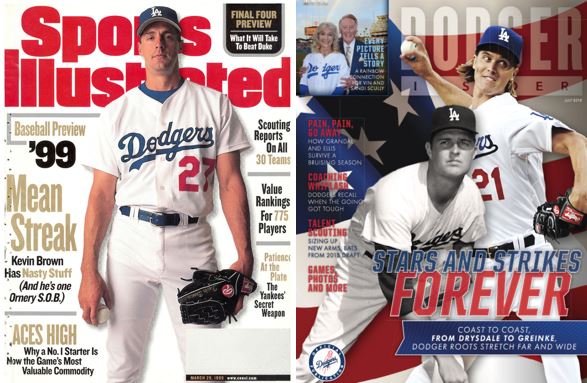Part Seven of Brothers in Arms: Koufax, Kershaw, and the Dodgers’ Extraordinary Pitching Tradition (order now!) — “The Hired Hands” — is the book’s shortest section, but it takes us to another key transition point for the franchise.
Right up until the final decade of the 20th century, the Dodgers signed or scouted, domestically or internationally, every significant starting pitcher they ever had as an amateur — or parlayed that homegrown talent into a trade for one. While the best things in life aren’t always free, the Dodgers rarely risked big dollars on pitchers from rival area codes. You could say it was pride. Or a conservative streak. Or feeling scorched by the relatively fruitless expenditures on the Dave Goltzes of the world.
But as the 20th century neared an end, the Dodger pitching tradition couldn’t survive on its own momentum. The team had to begin to look elsewhere for talent.
“The Hired Hands” focuses on the two main free-agent acquisitions by the Dodgers, Kevin Brown and Zack Greinke. Through the years, I’ve spent time here and there trying to correct the misimpression some have that the Brown signing was a bad one for the Dodgers. It was certainly an ornery one, but they got a great deal of excellence out of Brown during his five years in Los Angeles — and then traded him at just the right time, for Jeff Weaver and Yhency Brazoban.
For what turned out to be their seven-year investment in Brown, Weaver, and Brazoban, the Dodgers received 24.2 wins above replacement, an average of 3.5 per year. That’s the equivalent of Hideo Nomo’s 2003 season (218⅓ innings, 131 ERA+), seven times over.
More pleasant, if even briefer, was the three-year tenure of Greinke, who arrived as something of a promising enigma and soon became the guest you never wanted to leave, charming Dodger fans not only with a trio of dominant seasons but his reserved straightforwardness.
You look at how Zack Greinke pitched for the Dodgers in 2015, and it would have been easy enough to think he was simply an output of a computer program, what with all those alternating zeros and ones.
From Opening Day through the final out of the playoffs, Greinke took the mound for 239 different innings, and he allowed no more than a run in 231 of them. The number of ones and (mostly) zeroes was staggering — almost robotic — and went ever so far toward outputting the 1.66 ERA that was the lowest by a major-league pitcher in two decades.
And yet, there has hardly been a pitcher less automated and more human than Greinke, who possessed the unique combination of being one of MLB’s most natural athletes, cerebral thinkers, and fascinating characters.
Brown and Greinke weren’t products of the Dodger pitching tradition, and arguably, they illustrate its most tenuous chapter since it began in the post-World War II era. Nevertheless, they form another link in the chain and need to be appreciated in context to fully understand the team’s rich history on the mound.
Previously:
- ***NEW BOOK ALERT***: Brothers in Arms: Koufax, Kershaw, and the Dodgers’ Extraordinary Pitching Tradition
- Prologue: Dazzy Vance and the days before the Dodgers pitching tradition began
- Part One: The Kings of Brooklyn
- Part Two: The Two Emperors
- Part Three: The Post-Koufax Generation
- Part Four: The Modern Classicists
- Part Five: El Toro and the Bulldog
- Part Six: The International Rotation





Comments are closed.